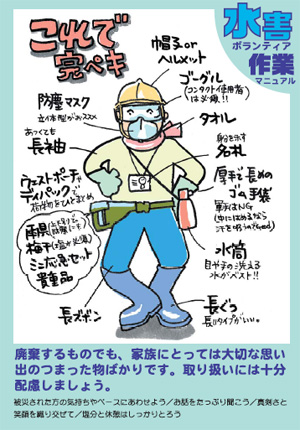
Clean-up crew in Iwanuma breaks for lunch, including FVJ members Jade, Sandi, Rajesh, and Camellia.
The Golden Week rush is over and volunteer numbers have dropped off steeply, but there remains a lot of work to do in the tsunami-affected zones in Tohoku. If you’ve been waiting for the right moment to get involved, this is the time!
Much of the work consists of clearing debris and sludge left behind by the tsunami. The tsunami has left a 2-3 cm crust of sludge on everything it touched. The SDF has cleared roads and public areas, but private property such as homes and fields must be cleared by hand, with shovels and wheelbarrows. The sludge and debris is piled near roads, and power shovels and dump trucks will later come to collect the piles. When it is too dry, the sludge turns to dust, crumbling and spreading and filling the air. Too wet and it becomes mucky and heavy. For that reason, it is imperative that as much sludge as possible is removed in the next few weeks, before the rainy season arrives, followed by the summer heat.
What to bring:
1) Volunteer Insurance (fukushi hoken) http://www.fukushihoken.co.jp/
Volunteer insurance not only covers medical care if you are injured while volunteering, it also covers costs if you damage someone else’s property or cause someone else to be injured. It is very affordable, ranging from around 500 to 1500 yen for 1 year’s coverage. Be sure to get natural disaster (saigai) coverage. You can acquire it at your nearest branch of the Japan National Council of Social Welfare.
2) Gear – If you are shoveling sludge and removing debris, you’ll need rubber boots and leather or rubber gloves and some good dust masks (a rating of N95 is recommended.) If you wear contacts, be sure to bring safety goggles. Boots with steel toes and/or metal insoles to prevent puncture injuries are best, depending on the environment in which you’ll be volunteering. If possible, find out as much as possible about the specific conditions where you will be working.
Other recommended materials include: shovels, buckets, towels, hat or helmets, long sleeves, long pants, rain gear.
3) Food, water and gasoline – in the early weeks following the disaster, volunteers were encouraged to bring all of their own provisions so as not to burden local supplies of food and gasoline. In most areas, this is no longer necessary, and buying food and water locally is in fact better for local businesses. You should pack a lunch each day when volunteering, though sometimes there is free food available for volunteers that is contributed by independent charities.
Etiquette:
1. Be discreet about taking pictures. Do not take pictures of disaster victims, evacuation centers, and private property.
2. When in doubt, err on the side of maintaining a solemn demeanor. You may be in the presence of people who have lost their loved ones, homes, livelihood, etc.
3. When in doubt, inquire before throwing things away. Letters and photographs can be collected for restoration by the owner or at the VC.
Where to go:
A number of Volunteer Centers are once again accepting out-of-prefecture volunteers. This list is current as of 5/13/2011, but be sure to check the VC’s latest information before heading out.
Miyagi
Kessennuma VC
Ishinomaki VC
Iwanuma VC* (some English)
Higashi Matsushima VC
Watari VC**
Yamamoto VC
Tagajo VC
Sendai VC
Shiogama VC
* Tents can be set up in park near VC. Volunteers can sleep in vehicles in parking lot near or opposite VC.
**Tents may be available to borrow.
Fukushima
Soma VC*
Minami Soma VC*
--> 5/17 New website for Minami Soma VC
Shinchi VC*
*out-of-prefecture volunteers are accepted if able to secure local accommodations. Please do not sleep in vehicles or tents.
Iwate
Inquire here for more information:
岩手県社会福祉協議会 地域福祉企画部 ボランティア・市民活動センター
Tel:019-637-9711
E-mail:vc-1@iwate-shakyo.or.jp






